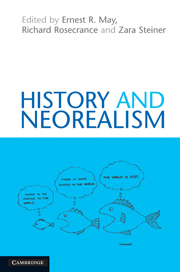Book contents
- Frontmatter
- Contents
- List of tables
- Notes on contributors
- Acknowledgments
- 1 Theory and international history
- 2 Transformations in power
- 3 Domestically driven deviations: internal regimes, leaders, and realism's power line
- 4 How international institutions affect outcomes
- 5 Not even for the seventeenth and eighteenth centuries: power and order in the early modern era
- 6 Austria-Hungary and the coming of the First World War
- 7 British decisions for peace and war 1938–1939: the rise and fall of realism
- 8 Realism and risk in 1938: German foreign policy and the Munich Crisis
- 9 Domestic politics, interservice impasse, and Japan's decisions for war
- 10 Military audacity: Mao Zedong, Liu Shaoqi, and China's adventure in Korea
- 11 The United States' underuse of military power
- 12 The overuse of American power
- 13 Redrawing the Soviet power line: Gorbachev and the end of the Cold War
- 14 Shared sovereignty in the European Union: Germany's economic governance
- 15 John Mearsheimer's “elementary geometry of power”: Euclidean moment or an intellectual blind alley?
- 16 History and neorealism reconsidered
- Index
- References
6 - Austria-Hungary and the coming of the First World War
Published online by Cambridge University Press: 05 June 2012
- Frontmatter
- Contents
- List of tables
- Notes on contributors
- Acknowledgments
- 1 Theory and international history
- 2 Transformations in power
- 3 Domestically driven deviations: internal regimes, leaders, and realism's power line
- 4 How international institutions affect outcomes
- 5 Not even for the seventeenth and eighteenth centuries: power and order in the early modern era
- 6 Austria-Hungary and the coming of the First World War
- 7 British decisions for peace and war 1938–1939: the rise and fall of realism
- 8 Realism and risk in 1938: German foreign policy and the Munich Crisis
- 9 Domestic politics, interservice impasse, and Japan's decisions for war
- 10 Military audacity: Mao Zedong, Liu Shaoqi, and China's adventure in Korea
- 11 The United States' underuse of military power
- 12 The overuse of American power
- 13 Redrawing the Soviet power line: Gorbachev and the end of the Cold War
- 14 Shared sovereignty in the European Union: Germany's economic governance
- 15 John Mearsheimer's “elementary geometry of power”: Euclidean moment or an intellectual blind alley?
- 16 History and neorealism reconsidered
- Index
- References
Summary
From 1899 to 1912 the annual recruit intake for the armies of Austria-Hungary remained fixed at 136,000 men. If in 1890 Germany had 160,000 more troops than its Habsburg ally, by 1914 the difference had increased to 465,000. Well might General Conrad von Hötzendorf, Chief of the Habsburg General Staff, object to participation in the Second Hague Peace Conference of 1907 with the curt observation: “the present condition of our army already has an appearance of the permanent limitation of armament.” The Danubian monarchy's failure to keep pace with its European rivals, as well as its allies, owed much to domestic political issues between Vienna and Budapest. But it also reflected a relatively passive approach to the monarchy's position in the European state system, a passivity that only the Second Moroccan Crisis (1911) and the Balkan Wars (1912–13) would totally disrupt. To be sure the government had nearly veered to war with Serbia (and possibly Russia) during the 1908–09 Bosnian Crisis, but once over there had only been a limited increase in Habsburg defense expenditures and no increase in manpower. If land forces and an aggressive foreign policy seeking power constitute central features of the “offensive realism” paradigm, then the Habsburg monarchy does not fit.
In keeping with John Mearsheimer's concept of “offensive realism,” indeed of all “realists,” the primary goal of the Austro-Hungarian monarchy before 1914 was to survive.
- Type
- Chapter
- Information
- History and Neorealism , pp. 103 - 128Publisher: Cambridge University PressPrint publication year: 2010
References
- 3
- Cited by



